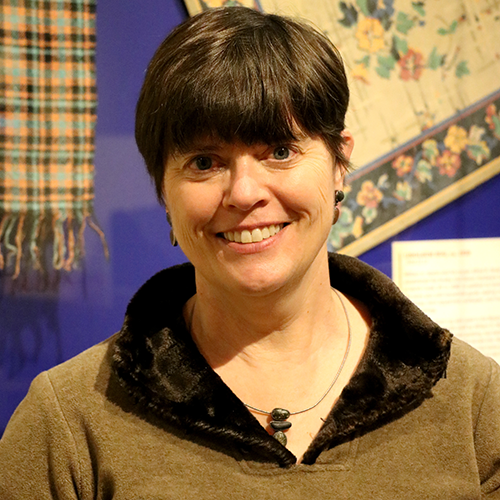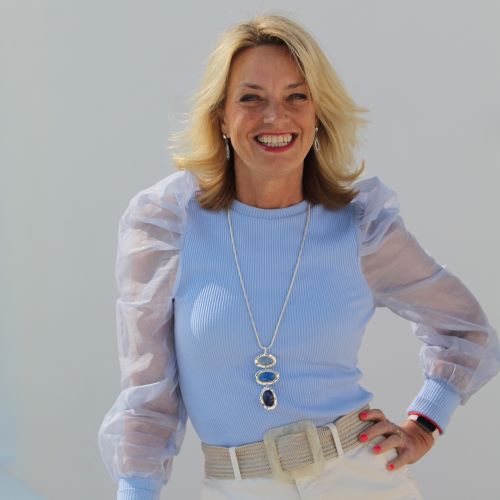Jennifer Bine
Episode 79: Are You (ADK) Experienced?, with Jennifer Bine
In an area known for its scenic mountains and lakes that can keep you exploring outdoors indefinitely – how do you draw people indoors to explore the history and present of this beautiful region? That’s the challenge for The Adirondack Experience – the museum on Blue Mountain Lake.
Today in this episode, Nicole is joined by Jennifer Bine, Director of Interpretation at the Adirondack Experience. Together they discuss challenges and opportunity in reshaping established institutions. They explore the history and vibrancy of New York’s Adirondack wilderness and the joy of sharing that experience with visitors to the region.
Jennifer holds a master in historical administration and museum studies from the University of Kansas and a Bachelor of Arts in history from Iowa State University. Her experience includes work with the Smithsonian Institute.
More on Jennifer’s Background
Thank you so much for joining me today, Jennifer.
Thank you, Nicole. I’m happy to be here.
I’m really looking forward to learning from you today and the perspective you’re going to bring to the conversation. Before we dive into the questions, can you tell us a little bit more about your story and your background and what led you to where you are today?
I get asked that a lot, actually. I am not originally from the Adirondacks, which is in far upstate New York. If you drive a little bit farther north from where we are, you start hearing French Canadian radio, so that gives you a picture of where we’re located. I grew up in the middle of Iowa and went to school there. My parents always wondered how I wound up in museum work, but they were the ones who took us to national parks, museums, and all kind of cultural destinations when we were kids. So it was only a matter of time before I realized that, “Oh, people work there. That’s cool.” I entered college wanting to work in museums, though I wasn’t quite sure how to get here. Ultimately, I did find my way, and it’s been a great 30-plus years that I’ve been doing this.
That’s awesome. I love how childhood experiences sometimes have such an impact and kind of drive what we do later in life.
Huge impact.
I think that’s just fantastic. That sudden realization that this museum is not just magically here, there are people that have curated this experience for me.
One person really made that come alive for me. We were visiting the Everglades, and this young tour guide was taking us around. I was so impressed that she was hopping off the tram and taking the alligators off the road so that the tram could go by. She has a job doing this- that’s great!
Creativity and Collaboration: Hands-on Learning
That’s awesome. I’m looking forward to hearing your perspective. On this show, we like to focus on creativity and collaboration. I’m sure there is a lot of both creativity and collaboration happening at the Adirondack Experience and in your role there.
To start, I want to talk about what you have done to help the Adirondack Experience stand out from the crowd. Visitors have so many choices of places they can go and experience. What are some of the creative offerings and things that you have put together to help stand out from the crowd?
I joined the Adirondack Experience in 2013. I was brought in specifically to head up the creation of a new exhibition here. We were renovating our largest exhibition gallery to create a show called Life in the Adirondacks. It looks at the environmental history of the Adirondacks, what brought people to this place, how they had to change in order to make a living in the Adirondacks, which is a very vigorous environment and very remote, and also how then people have impacted the Adirondacks. It was really quite a ride to put together this 19,000 square foot exhibition and make it very interactive, very up to date. I think that has been a big step forward for us, and it is part of an ongoing master planning process that we’re going through here.
The museum has been around for 61 years. It has always had a prominent place in the Central Adirondacks as a destination. It has a terrific collection of workday objects, things that would be used in the home as well as in logging and mining and ice harvesting and a host of other different kinds of work that go on here in the Adirondacks. We do have a very unique story to tell about the human presence in this place that so many people call a wilderness.
Interesting. Can you talk a little bit about the new exhibit, the Life in the Adirondacks exhibit and some of those interactive elements? I know I’ve seen in my own experience visiting museums and places like the Adirondack Experience that there are a lot of new technologies being used and a lot of new ways of presenting information.
So many.
I’m wondering if you can share some of the ones that you’ve worked with and that you find kind of integral to what you’re trying to accomplish.
The museum was always kind of cutting edge even when we opened 61 years ago. We had some of the first audio programs available to people, interactive displays, dioramas, and things like that. Then we sort of rested on our laurels for a few too many years. You’re right. The new exhibits do have a lot of very cutting edge interactives and A/V presentations.
There’s an introductory theater that is semicircular so that you really feel immersed in the Adirondack environment. You get a sense of the expanse of this place, and that video takes you places that many people otherwise couldn’t go: up on top of mountains, and hiking deep into the forest. That’s not an activity that everyone can engage in, but it’s one everybody who comes here does appreciate.
Then moving on from that, we have digital databases that allow you to dive into our collection more deeply and explore on your own. Happily, this coincides nicely with an online database we have of our collection, so if you have a very specific interest, you can look up objects there. It is the first time we’ve had it available on the floor in the gallery, so if a visitor who is here has an immediate question, they can get that answered.
We wanted to have a number of opportunities for people to put themselves in the picture and understand that just by being in the Adirondacks, you’re influencing the place. We wanted to reinforce that through our interactives.
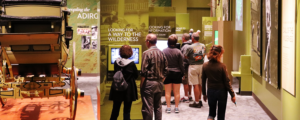
[bctt tweet=”“We wanted to have a number of opportunities for people to put themselves in the picture and understand that just by being in the Adirondacks, you’re influencing the place.” – Jennifer Bine #WhyCollaborate #podcast”]
We have a large map that is projected up on one of the walls, and this wall is 25 feet tall, maybe taller than that. I don’t remember the numbers exactly off the top of my head. You go to a kiosk. You identify a place that’s particularly special to you. You type in a reason why that is special to you, and then take your picture, and then that populates the map overhead. You start seeing where you fit in with other people who are visiting the region. That includes not only the people who are there just ahead of you but some rather famous people who have been here as well.
Some of the later technologies that we took advantage of is an integrated A/V and mechanical interactive where you can step inside a guide boat – a very traditional rowing boat from the Adirondacks – and row across a lake. What you do with the oars affects what you see on the screen in front and behind you as you move, so you get a sense of how a guide boat actually works. That’s been incredibly popular with our visitors. There are several others in the gallery, but those are just a couple of very specific kinds of things that we have added that has made it very intriguing to particularly families who are coming to the museum now who haven’t been here before.
I imagine that some of those elements would be very attractive to families. I like that, along with the physical pieces in the museum, you’re getting to virtually experience the Adirondacks and the nature that’s around you, things that some people might not be able to experience, which I think is really very cool.
A lot of people think of museums as their rainy day activity when they come to the Adirondacks. It is no joke when we’re asked who our competitors are. Our competitors aren’t so much our neighbor cultural institutions and science-based institutions. It’s really these lakes and our mountains in the region which is what draw people here. If it’s a beautiful day, people want to be on the lakes. We have to make a conscious effort to connect with what people find important when they come to the Adirondacks and why many of us have come to live here – because we love this environment, and we want to understand it better.
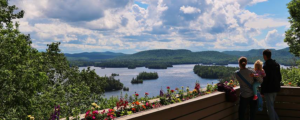
[bctt tweet=”“Our competitors aren’t so much our neighbor cultural institutions and science-based institutions. It’s the lakes and our mountains in the region which is what draw people here.” – Jennifer Bine #podcast”]
That’s really great. You’ve mentioned the environment several times, but you’ve mentioned it in a way that, with this new display and other elements within the museum, you’re really trying to educate the public on their impact on the environment. There’s been a lot of talk about over tourism and how to take care of these places we’re promoting. We want visitors to come, but we also want to make sure that we preserve and protect them. Can you expand on that just a little bit – some of the things that you’re doing to help with that message and to help educate and protect and preserve?
Well, we talk about the development of the Adirondacks and things that people did for economic reasons or because they didn’t know better. Logging was a huge industry here. Because of the way it was done in the early years, it was not great for the land. This is a very rocky thin soil, and if you take out all the trees, that’s very bad for the land.
Subsequently, we do have different guidelines for logging today, and our forests are rebounding. Likewise, the first trails were sort of bushwhacked up to the sides of the mountains to get to the top of the mountains, rather than being carefully laid out so that they did not erode. We look at how things were done, how we’re trying to do things now, and the people who are trying to aid the Adirondacks in surviving into the 21st and 22nd century and beyond. That’s not just on the very practical end of things looking at how you go about building a trail and practicing “leave no trace” camping, but also some of the scientific work that’s being done to better understand this place. Like any ecosystem, it is incredibly complex, and one small thing that this community does it has a major impact on the waters adjacent to them and the waters downstream. We’re trying to make sure that people think about that all the way along.
We do that not only through our exhibits but also through public programs, lectures, and we have a very active pre-K through 12 school program that we do a lot of outreach with that as well.
Creative Solutions to Challenges: Honoring the Past, Looking into the Future
That’s terrific. Those are great ways. I like the example about the practical leave no trace camping or how do we build a trail, but it’s thinking more kind of globally and how what I am doing right here right now is impacting communities, my neighbors, and neighbors maybe downstream, et cetera. That ongoing conversation is an important one to have.
Switching gears just a little bit, one of the things I like to explore in this section on creativity is the creativity that comes from problem-solving, or when you’re faced with a challenge. I’m wondering if there is a challenge that comes to mind for you either at Adirondack Experience or a previous employer, where a challenge was faced creatively.
I think the most obvious one here at the museum was one we had for quite a number of years. We had peaked out as far as attendance in the 1990s. Then it started to wane. Nobody really understood why. We don’t have a gate to the Adirondack Park. It’s a very different sort of park. There are 100 outlets to get in and out of the park, and nobody knows what overall visitation is. That’s very hard to get a handle on it. We weren’t sure if our visitation was falling because visitation to the Adirondacks, in general, was falling. We were not sure what was going on. Ultimately we can only control what we can control.
We took a hard look at what our exhibitions had been doing, what we were offering to the public. Our board decided we needed to make some pretty radical updates to our exhibition program, which was the birth of this Life in the Adirondacks exhibition and future exhibitions that we are starting to work on now. That was a long-term planning process.
The planning process revealed some interesting things. We were doing interviews with people who come to the museum and, more importantly, people who don’t come to the museum. We learned that the word “museum” actually does not have great resonance with a lot of visitors who are coming to the Adirondacks region but not coming to the museum. We took the rather radical step of looking at our name. For years from our inception, we were called The Adirondack Museum. It was a proud name, and a lot of people were very, very attached to it. After a lot of soul searching and a lot of research, we decided to change the name to Adirondack Experience, The Museum on Blue Mountain Lake. The tagline we’re hoping to eventually not use so much because it does make for a very hefty name.
We did make that change last April at the same time as we premiered a new website. We did get some pushback from people who were very invested in the old name, but as we sat down and talked with them in public forums and one-on-one and through the news media, people have really come to understand why we did what we did. We have not received anywhere near the pushback that we anticipated for making that change. We have a new logo, lots of new collateral materials that we’re sending out, new brand guidelines and things like that. It has attracted a lot of attention to the museum, which has been great.
I think that is great. I can completely imagine and understand the difficulty in changing a 61-year-old’s institution that has been known as the Adirondack Museum to the Adirondack Experience. But I can also completely appreciate the evolution of what you’re providing and where we are in 2018 and what the visiting public is looking for. They really are looking for that experience.
Exactly.
You mentioned that research helped inform you. Did you research the name change? What type of research did you utilize in the decision making process?
We used a number of different consultants who researched for us. One was an economic consulting company that was helping us determine how the amount of funds we could raise, how much to expect from grants or government agencies, and also just some basic perception issues about the museum. We also worked with an audience researcher who did phone interviews with members and visitors to the museum who we knew how to contact and also non-visitors to the museum to find out what they thought of the Adirondack Museum as it was called at that time, and how they made their decisions about spending their time.
The last group that we worked with was a PR firm to help us craft a marketing campaign. They came along rather late in the game, but they did do market research that helped us decide how to roll out the new name and how to reach out to people in the most effective manner possible. They also developed our new website. That continues to evolve. Those things are never static. You never get it exactly perfect the first time.
Yes, that’s the biggest challenge with the website, it is never static when you launch it.
It shouldn’t be.
It doesn’t need to be perfect on day one of launch because it’s going to change and evolve pretty much every day from launch and after that.
I’m wondering with this new brand, how is that informing and impacting the work that you are doing in your role of interpretation?
As I mentioned, one of the sub-departments I oversee deals with public programs. Those are major events we hold here on the museum campus during our open season. We have lectures that happen throughout the year and other sorts of demonstrations; craft demonstration, artist demonstrations, workshops, that sort of thing. We’re trying to find more and more ways guests can actually have a hand in doing things when they get to campus, so it’s not a passive learning environment. So as a visitor you really are deeply involved in what’s going on. If you’re here for a workshop and you’re learning how to, for instance, weave your own pack basket, which is a classic Adirondack artifact here, or learning some Mohawk pottery making techniques, you are actually getting your hands dirty. We really want to push that.
We also promote things for families who come on the spur of the moment, so their kids can be participating actively and not just sitting quietly looking at the lovely artifacts and the artwork. We have a terrific collection. There are lots of great things to look at, but we need to appeal to a whole variety of learning styles and recreational styles because we are trying to serve both of those needs when people come to a museum.
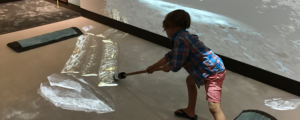
[bctt tweet=”“We need to appeal to a whole variety of learning styles and recreational styles because we are trying to serve both of those needs when people come to a museum.” – Jennifer Bine #WhyCollaborate #podcast”]
That’s great. You know, it’s interesting because you’re thinking not just of audiences, but about their learning styles and the way they like to recreate and interact.
Some of us adults really like the hands-on aspect of things. We have some dress-up clothes in the new exhibition, and we made a point of including not just kids size dress-up clothes, but adult size too. They are getting a hoot out of it.
That’s great.
There are so many selfies taken in those areas of the exhibition.
That’s really awesome. You’re right. I think that’s fantastic.
Now, looking into the future, is there a project or something that you’re working on that you’re really excited about?
A couple of things. In the near term, one of the sections of the gallery that we were really excited about is called “A Peopled Wilderness.” It explores the Native Americans who have called the Adirondacks home for a millennium. It was a subject that the museum had never really treated before. In fact, up until maybe 10-15 years ago many of the best historians from the Adirondacks were saying, “Well, you know, they came here seasonally, came here to hunt, fish, and then they went back to their homes.” That’s a very Western view of the occupation of a landscape. In fact, the Adirondacks were very much a native place and have been so for 30,000 years.
We are finally telling that story in our galleries, not just people of long, long ago. There are still native people who call the Adirondacks home and have deep bonds with it. We were very excited to include that section in the new exhibit.
This year we’re creating an art market to be held in August, I believe. We’re inviting Mohawk and Abenaki artisans and artists to come and present their work. Most people who do high-end artwork and craft in the Native American communities go far afield to sell their best work. They are going to Santa Fe to see it. As a result, our concern and our neighbors are concerned that there continues to be a lack of awareness of the Native presence here. This is an opportunity to do some economic development work in association with the Abenaki and the Mohawk people of the Adirondacks and also provide a great educational opportunity and shopping opportunity for our visitors.
That’s fantastic. That sounds exciting.
Long term we’re also looking at creating another new gallery that highlights the art and design of the Adirondacks. So we’re looking not only at our painting collection, which is a fantastic regional collection of paintwork, oils, watercolors, prints, photographs. We’re also highlighting the traditional rustic furniture of the Adirondacks, the architecture of the Adirondacks, which is distinctive. We want to shine a light on what makes this place unique and how it has inspired artists and artisans. That’s something that we’re looking at opening in 2020, maybe 2021, so that’s a more long-term project.
Coopetition Opportunity
Both of those sound fantastic, and we’ll look forward to hearing more about those and seeing them when they open. I wanted to use that to jump into another question. You were describing the project with the Native Americans and the art market. You began to talk about economic development and where you’re crossing over into and supporting other sectors outside of travel and tourism, or even beyond being a historical museum.
That is a nice segue into this next section I would like to talk about, which is collaboration. In travel and tourism, we work in so many different collaborations all the time. I like to call some of these collaborations “coopetition,” because I see so often where perceived competitors might come together and collaborate on a project or program that will actually make it a win-win for all parties involved, doing something bigger that they can do on their own. I’m wondering if you can talk about a collaboration that has worked for you in the Adirondack Experience, and what made that particularly special.
We’ve worked with a lot of different cultural organizations in the past. We’ve worked with the Wild Center in Tupper Lake about 30 miles away. There’s the Traditional Arts of Upstate New York, which is in Canton. We have invited their experts to come lecture at our museum, which increases awareness for them. We’re the biggest museum in the Adirondacks. Anything we can do to help let people know about other experts that are out there that they may not be aware of is pretty great.
I think my favorite projects that I’ve worked on which has less to do with tourism honestly, was the Jefferson Project out of Lake George. It’s a consortium of three organizations, Rensseleaer Polytechnic Institute, IBM, and the Fund for Lake George. They work together to do research work on Lake George to really understand what’s going on with that lake. The hope is to take the technologies they’re developing to understand the lake and take them to scale so that we can understand lakes across the Adirondacks, across the world. In some cases, we will be able to take some of those technologies and use them in completely different environments so we can do better long-term monitoring of those locations.
We work together with that consortium to create an exhibit in Life in the Adirondacks that highlights what they’re doing with The Jefferson Project. That’s really created a very exciting educational opportunity for our visitors and increased awareness of what’s happening on Lake George. That was definitely a win-win for both of us in that case.
We’re always looking to collaborate. One of our biggest challenges here is that we are in the middle of Hamilton County, which is the only county in the Adirondacks that is completely contained within the blue line, which is the perimeter of the park. We don’t have a major hotel anywhere close to us here at the Adirondack Experience. Many travelers are not willing to stay in small motels, campgrounds, cabin kind of settings. Some of the cabins don’t want to rent for a single night or two nights. They’re looking for week-long rentals. We’re actually looking to identify a collaborator hopefully that will be interested in building a hotel in the Blue Mountain Lake region. We’ll then work with them to create programming and enticements to draw more people to the Central Adirondacks and stay in this area, so that’s a major long-term project, but we really do need this. The museum is putting a lot of muscle behind that.
That’s great. It is a long-term project, but what I think is interesting is that you’re recognizing that to continue the work that you’re doing and to attract those visitors, you need to look at the whole of what you have to offer, and it’s beyond the walls of your organization.
Right.
I think that it takes many to attract a developer like that and so I’m sure that you’re working with several folks within your country and probably within the state to do that.
Absolutely. It’s a level of infrastructure that we need in order to be successful, but we’re not in a position to actually provide ourselves with. We don’t have control over that, so we have to collaborate in order to see it happen.
Right. I think that’s a fabulous example. I like the example of The Jefferson Project as well. Although you said it’s not directly travel and tourism, it really is because those lakes and the mountains, especially for your region, that’s your biggest attractor to bring people. That’s what they come to enjoy. Projects like The Jefferson Project are so important to maintaining those assets and the health of those lakes and understanding them. I think that’s another really great example. I love that you have an exhibit in the Life in the Adirondacks exhibit within your museum as well. I think that’s great.
I’m very excited about having that.
Best Practices for Entering a Partnership
I’m wondering if you have any advice for our listeners on partnerships or collaborations that you’ve worked with, any best practices or pearls of wisdom if you will, that folks who are thinking about collaborating or who might be starting a partnership should be thinking about?
You know, both from here and my previous work at the Smithsonian, we did a lot of collaborative work there as well, I think the most important thing we did at the outset of any joint project was establishing goals and guidelines. We had a very elaborate letter of agreement. It was a little intimidating when we first presented to collaborators, but everyone came to understand that by being that detailed in what we needed, what we expected, determining what you need and expect in order to be a collaborator with us, getting that nailed down at the very outset was absolutely vital. There are a lot of points to go over, but a solid understanding at the outset, having it in writing, really prevented a lot of troubles down the road. People were perhaps surprised by something that the other party needed or expectations weren’t met, so it was really critical to get that kind of thing established up front and make sure that you had a collaboration that actually would create synergy rather than becoming combative.
As long as you had those things established early on, you were going to have a successful relationship no matter what. At the end of the day, you were going to shake hands and still be friends and move forward happily.
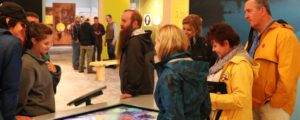
[bctt tweet=”“As long as you had goals established early on, you were going to have a successful relationship no matter what.” – Jennifer Bine #WhyCollaborate #podcast”]
Right. Absolutely. I think that that’s great advice having it in writing, getting that in advance, and as you said even though it might be intimidating at first, but as you walk through all those details and expectations, I love what you just said that it helps create synergy. I think that’s a great kind of roadmap and advice for entering into those kinds of collaborations.
Well, it gives you an avenue to ask those awkward questions that otherwise might get swept under the rug, and that gets them out in the open.
Yes. That’s a great point. Well, Jennifer, this has been an awesome conversation as I knew it would be. Before we say goodbye, are there any final words that you would like to share or anything that I didn’t ask that you were hoping you could share with us?
I think one of the challenges here is that we have a rather unusual market here in the Adirondacks. We are very remote. People come to us because of our outdoor opportunities. Any chance we have to collaborate with our neighbors, whether it’s Great Camp Sagamore, or the Wild Center, or the folks in Lake Placid, that’s a really good thing. We can encourage people to come here and understand that they can have a really rich varied experience when they come to the Adirondacks. It is a place that has something for everyone, not just the heartiest of the hearty.
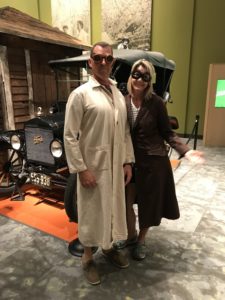
[bctt tweet=”“Any chance we have to collaborate with our neighbors, that’s a really good thing.” – Jennifer Bine #WhyCollaborate #podcast”]
Yes. I can attest to that. My family and I travel to the Adirondacks quite a bit, so rich and varied experience, absolutely. I really appreciate you taking time out of your busy schedule to be with us today and we’ll look forward to connecting with you again.
Okay. Thank you so much.
Resources:
We value your thoughts and feedback and would love to hear from you. Leave us a review on your favorite streaming platform to let us know what you want to hear more of. Here is a quick tutorial on how to leave us a rating and review on iTunes!
